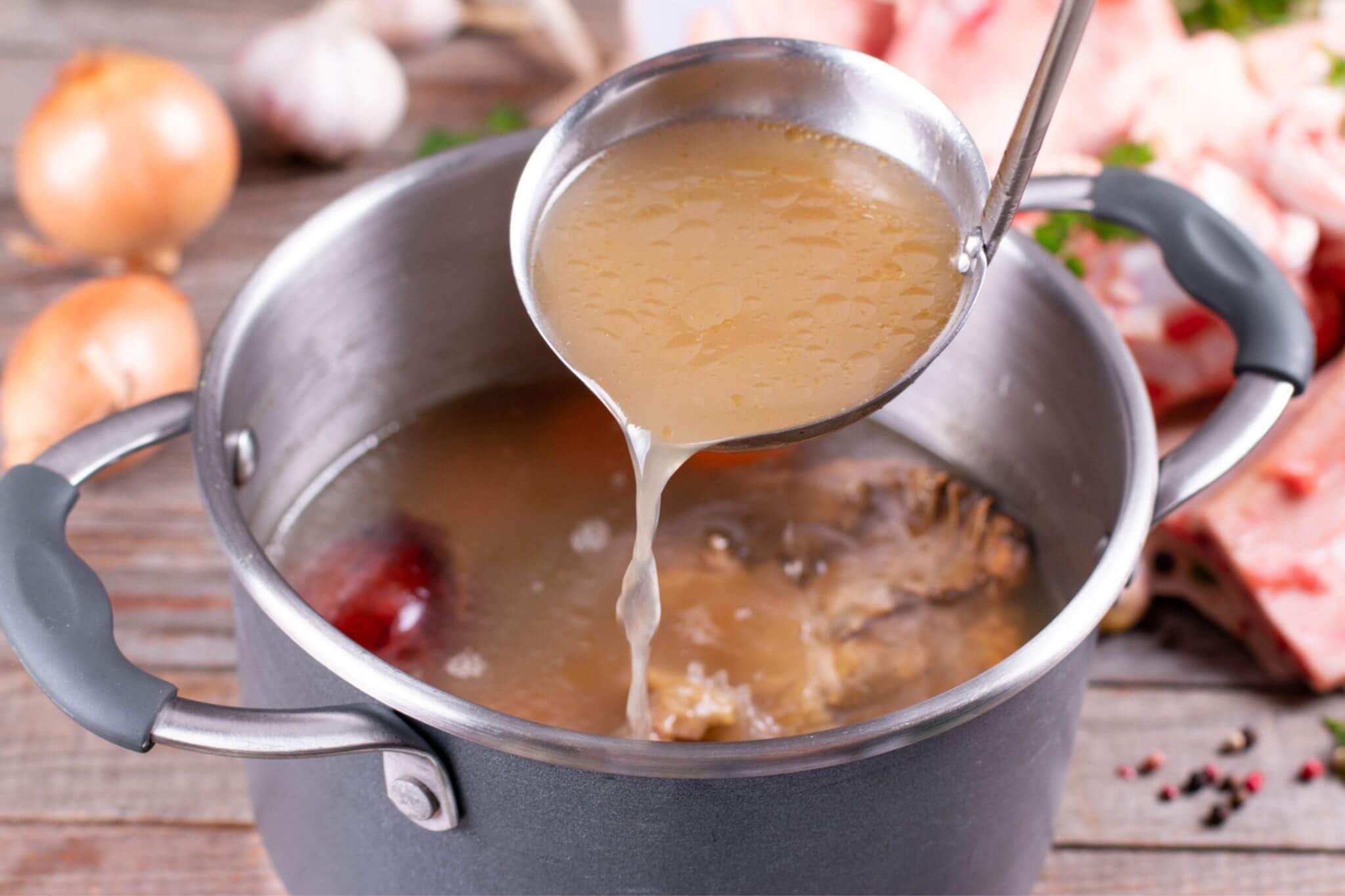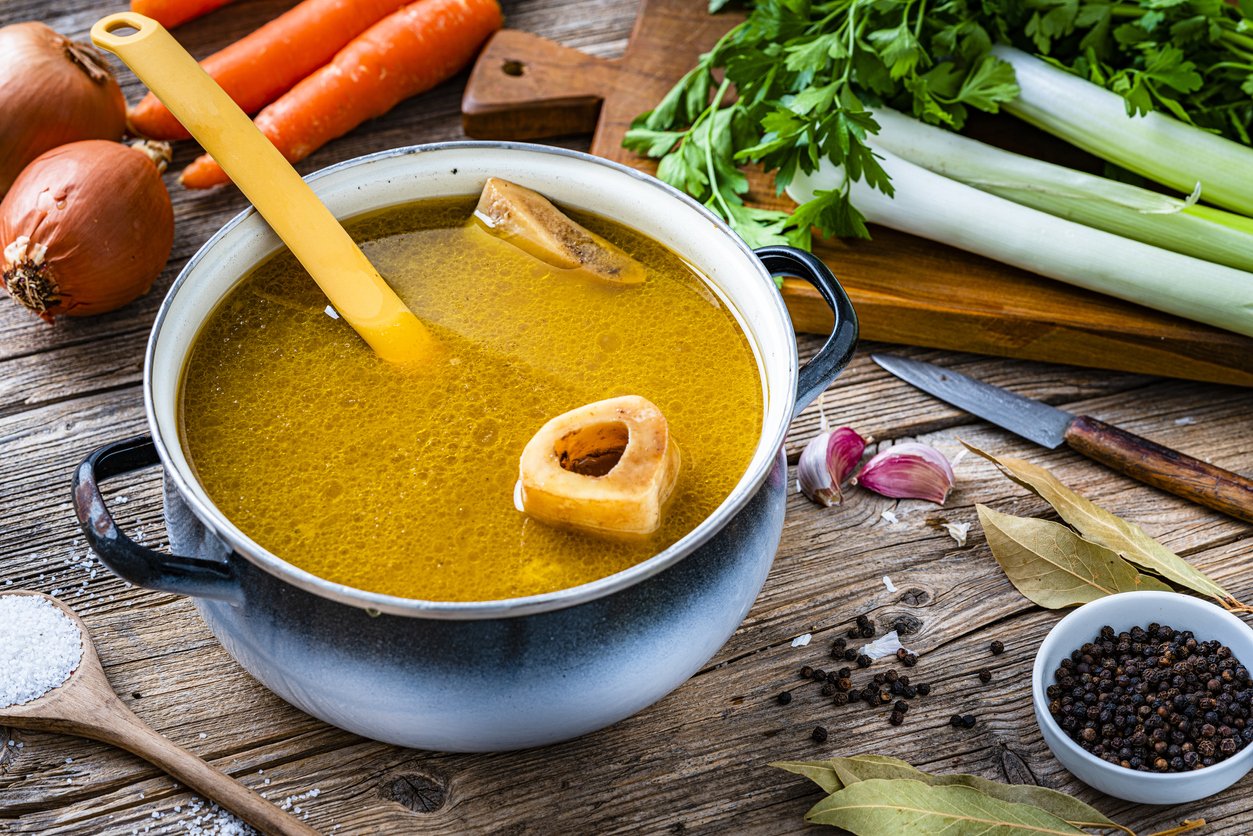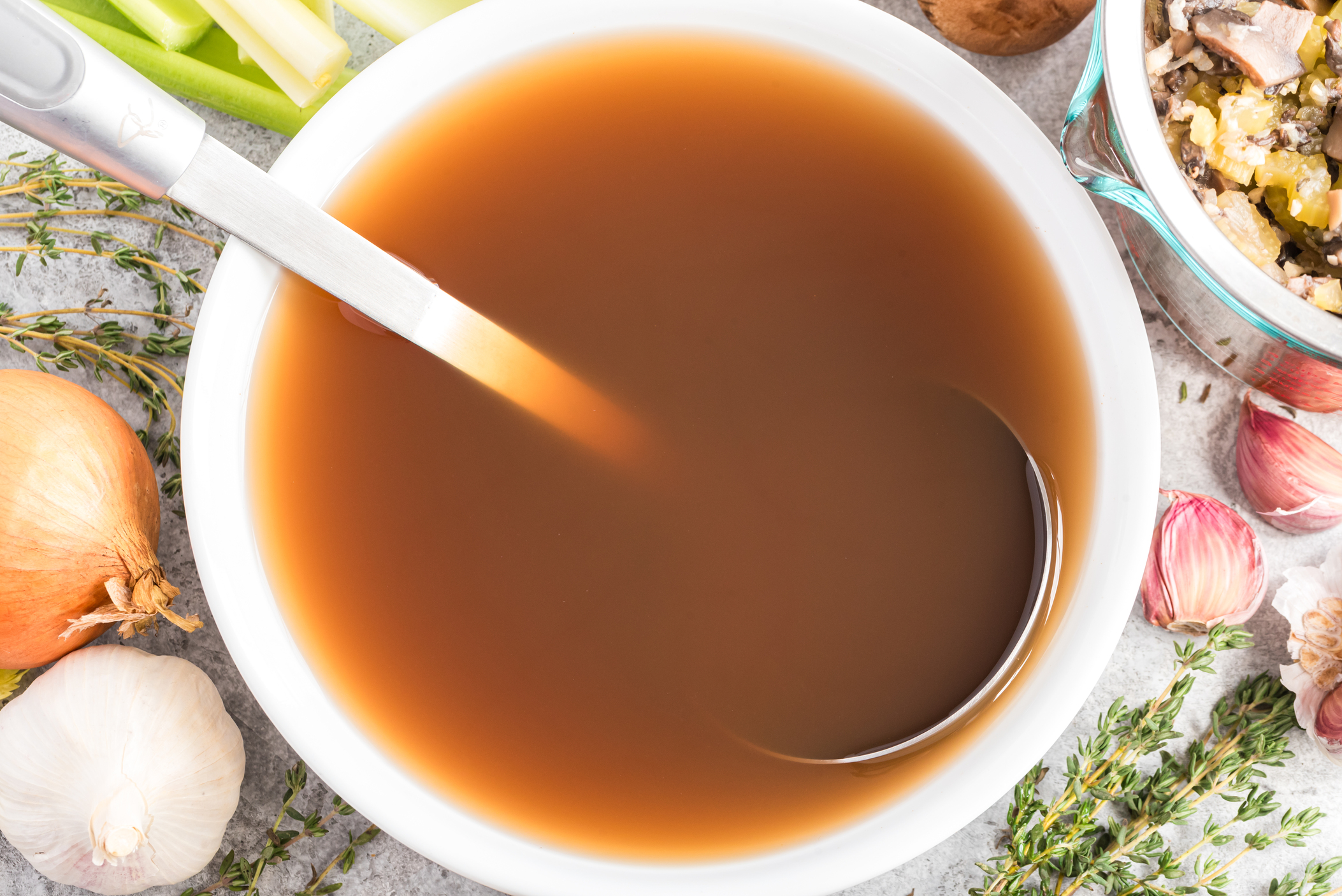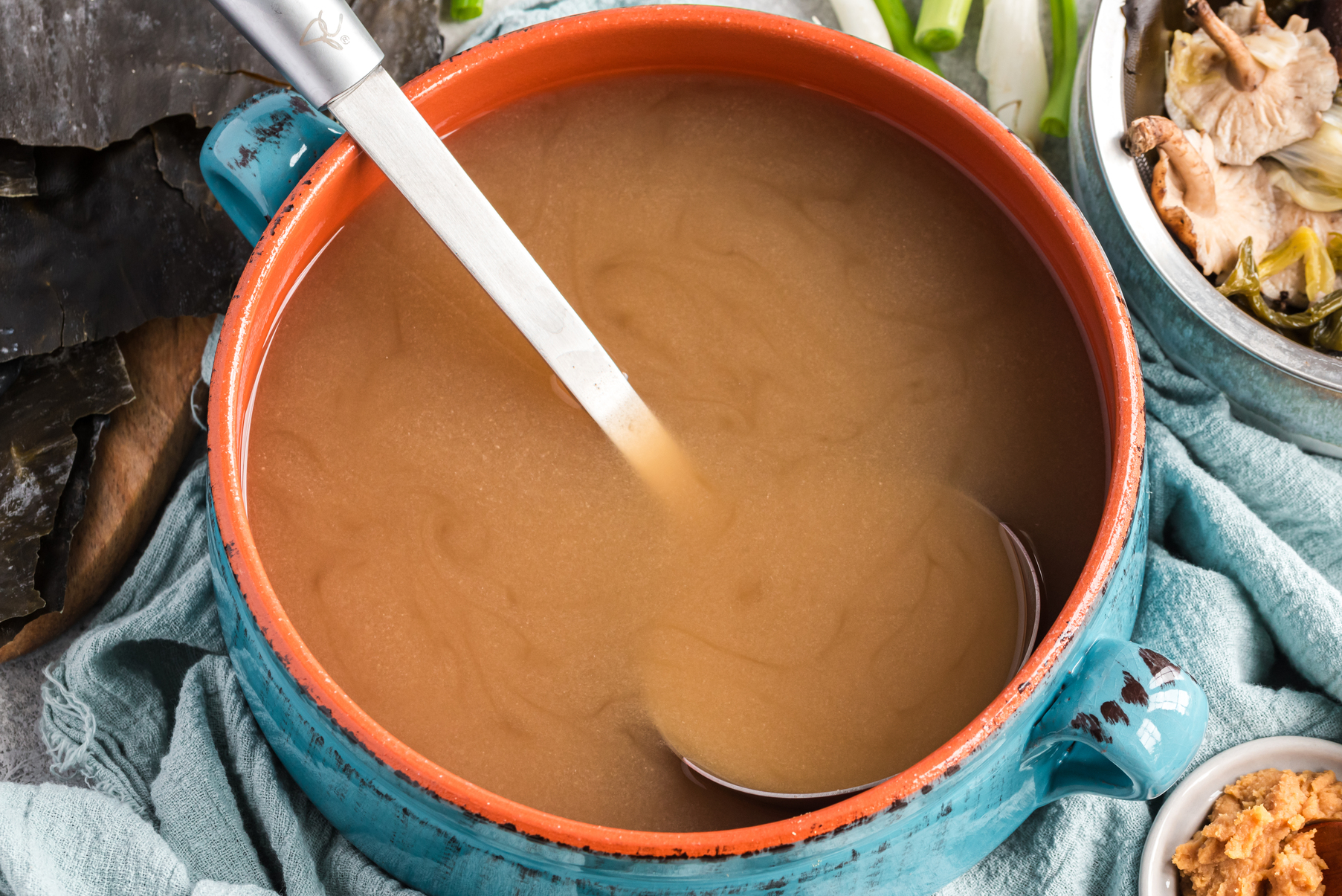Bone broth has become a popular health trend over the years. Countless blogs, media outlets, and health influencers tout its many presumed health benefits. And marketing claims for bone broth call it a “magical elixir” that can cure leaky gut — and help with all manner of ailments from arthritis to weakened immune systems.
Even some restaurants serve bone broth now. Believe it or not, there’s a bone broth to-go chain in New York City. A quick Google search will show that bone broth products are now marketed for dogs and cats as well.
But what’s the truth about bone broth? Is it the miraculous tonic it’s touted to be? And are there any bone broth side effects or other concerns to consider?
What Is Bone Broth?

First things first. Bone broth is not the same as regular chicken broth, beef broth, or other animal broth. It’s actually closer to a stock. Bone broth is made by boiling the roasted bones, and sometimes connective tissue, of animals for a prolonged period of time. It’s often made in a slow cooker or other “set it and forget it” appliances. The long cooking time is mainly what separates it from regular types of broth.
The cooking time of bone broth — ranging from eight to over 24 hours — is intended to draw vitamins, minerals, and collagen out of the bones and into the broth. The latter is why these types of broths and stocks have a more gelatinous consistency than a typical broth.
Acids like apple cider vinegar, red wine, or tomato paste are also sometimes added to break down the beef bones (or pig, turkey, or fish bones) and extract nutrients. The liquid is then strained, the solid parts discarded, and the remaining broth seasoned. Often vegetables, such as carrots, onions, and celery, are also included.
The broth is typically sold in liquid form, but some packaged brands have also dehydrated it into a powder for “bone broth on-the-go.”
Why Is Bone Broth So Popular?
The concept of bone broth isn’t new. Many cultures, including our Stone Age ancestors, made broths from animal bones thousands of years ago. But its current popularity is linked in no small part to extensive marketing efforts as well as to promotion from health influencers.
Bone broth advocates say it can relieve joint pain and osteoarthritis, detoxify the liver, aid in wound healing, slow the aging of skin, support digestive health, balance hormones, increase energy, strengthen bones, improve quality of sleep, alleviate symptoms from certain autoimmune conditions, and even boost immune function.
As a result, bone broth is also now providing (not insignificant) profits to celebrities, food businesses, and health gurus who are cashing in on the craze. There’s even a Bone Broth Diet created by Dr. Kellyann Petrucci, a health influencer and naturopathic doctor.
Retail sales of bone broth products increased from $17.54 million in 2017 to $68.78 million in 2023. And according to a market research study, the global bone broth market is expected to continue rising for the foreseeable future.
So, What Does the Research Say About Potential Bone Broth Health Benefits?
Interest in bone broth continues to increase because of the long list of benefits it’s said to provide. But what does the science actually say? Does it measure up to the health claims?
Claim #1: Bone Broth is a Nutritional Gold Mine

Bone broth nutrition is one of its biggest selling points. Allegedly, this type of broth is a low-calorie, high-protein food that provides significant minerals such as calcium, phosphorus, potassium, and magnesium.
The earliest study to mention bone broth is from 1937, which looked at the nutritional value of both animal-based and vegetable broths. The researchers concluded that while neither was a very good source of nutrition, the broths found to provide the highest mineral content were the ones that contained the most vegetables.
Far more recently, in 2021, a study in the journal Medicina analyzed bone broth and found that it was not an especially good source of essential minerals, especially in comparison to recommended daily intakes.
While marketers tout animal broths for their mineral content, it’s the vegetables generally used in the cooking process — not the bones — that may actually be providing many of these helpful nutrients.
An average cup of bone broth contains 0–19 mg of calcium and 6–9 grams of protein. That may be all well and good, but this protein content is not terribly impressive when compared to some other sources of these nutrients.
- 1 cup cooked collard greens = 268 mg calcium
- 1 cup navy beans (boiled) = 126 mg calcium
- 1 bunch cooked broccoli raab = 515 mg calcium
- 1 cup baked beans = 14 grams protein
- 1 cup cooked quinoa = 8 grams protein
- 3 Tbsp of hemp seeds = 10 grams protein
Bone broth also doesn’t include the fiber that comes along with whole, plant-based sources of protein.
So yes, bone broth does provide some calcium, protein, and other nutrients. But so do many, many other whole foods.
A cup of cooked collards contains at least ten times as much calcium as a cup of bone broth. And a cup of baked beans contains nearly twice as much protein. But in fact, most Americans may be getting too much protein (at least from animal sources), anyway.
Claim #2: Bone Broth Will Strengthen Bones, Relieve Achy Joints, and Keep Skin Youthful
Collagen is the main protein in your body. It protects your organs, joints, and tendons; holds together bones and muscles; and maintains the lining of your gut. Your body makes its own collagen, but as you age, you won’t make quite as much of it.
Bone broth is high in collagen, and many people believe this is one of its major selling points.
Unfortunately, there is no evidence that eating collagen, whether in broth or otherwise, is directly helpful to your body. Many experts agree that because your body doesn’t absorb collagen in its whole form, the idea that eating collagen helps your body increase collagen levels just isn’t true. Your body breaks collagen down into amino acids. So, in the end, it’s just another form of protein.
You’ve probably seen collagen supplements sold for skin, nail, and hair health. Some research suggests that collagen supplements may potentially help to reduce visible signs of aging, relieve joint pain, and prevent bone loss. But the collagen in supplements is hydrolyzed, or broken down to make it more usable for the body. The collagen in bone broth is not hydrolyzed and does not have the same effects on the body.
If you want to help your body build collagen, the best way is to eat a diet rich in leafy green vegetables because plants offer rich sources of the phytonutrients your body needs to make collagen.
These phytonutrients in plants include:
- The vitamin C found in citrus fruits, dark leafy greens, bell peppers, kiwi, berries, and broccoli. Vitamin C is a powerful antioxidant that can help protect your skin, inside and out.
- The vitamin E found in sunflower seeds, almonds, wheat germ, spinach, and broccoli. Vitamin E works with vitamin C to promote collagen synthesis.
- The vitamin A found in carrots, sweet potatoes, winter squash, dark leafy greens, cantaloupe, and apricots. Vitamin A helps regulate antioxidant responses that can affect your skin’s ability to fight free radicals.
- The amino acids glycine, proline, and lysine — found, among other places, in dark leafy green vegetables, soy, nuts, seeds, and legumes. These amino acids play an important role in collagen formation.
- The sulfur-containing foods, such as garlic, onion, and members of the cabbage family, may also promote collagen production.
The bottom line is bone broth does contain collagen, but it doesn’t necessarily support collagen formation. But vegetables and other plant foods can be powerful allies in keeping your skin young, your bones strong, and your joints healthy.
For more on collagen and how to increase your body’s production of it, see our article here.
Claim #3: Bone Broth Is Good for Your Immune System

At some point in your life, you might have eaten a bowl of chicken soup when you were sick — and it might have even helped you feel better.
And in fact, a 2000 study in the journal Chest found that chicken soup could prevent white blood cells from migrating — thus preventing the worsening of upper respiratory infection symptoms.
But the researchers conjectured that the vegetables in chicken soup — not the chicken alone — might offer helpful effects when it comes to battling infections.
Would vegetable soup have been just as effective? Or more effective? We don’t know. But it seems clear that the vegetables, at a minimum, played an important part.
Warm beverages, in general, may be helpful when battling a cold because they provide hydration and help regulate body temperature. But there’s no evidence that bone broth has unique immunity superpowers. And to date, I’m not aware of any published studies about bone broth and viral illness in peer-reviewed medical journals.
Claim #4: Bone Broth Is Good for Gut Health
Bone broth is said to be good for digestion and potentially therapeutic for leaky gut syndrome — a condition in which substances can leak from your intestines into other tissue, causing inflammation.
There is a lot of gelatin in bone broth. And some research done on rats (our view on the use of animals in medical research is here) indicates that gelatin could bind water in the digestive tract and protect the lining of the intestines. There’s also some rodent research that found that the amino acids in bone broth could have anti-inflammatory effects, which might help with gut conditions like ulcerative colitis. But while both of these studies show potential in rats, it doesn’t mean bone broth can do the same for humans.
We have a very different intestinal lining than rats. It’s possible that it could help. But at this point, all we have is a theory.
What’s not a theory, because it’s been well documented, is that you can support your gut health with a variety of fiber-rich plant foods. Plant-based foods, including fermented foods, help to maintain a healthy gut microbiome by providing prebiotics, probiotics, and the lesser-known postbiotics.
For more ways to support digestive health with food, see this article.
Claim #5: Bone Broth Can Help You Lose Weight

Mark Wahlberg and other celebrities have touted bone broth as a means to lose weight. When getting in shape for the movie Spenser Confidential, Wahlberg told Entertainment Tonight he ate “just bone broth and then steamed vegetables after the first three days and then a little bit of protein at night, and that was it.”
While he did end up losing weight, it’s likely because he was engaging in intermittent fasting and a reduction in calories rather than anything in the bone broth directly contributing to his weight loss. Intermittent fasting may help fat-burning hormones in the body work more efficiently. But bone broth is not a magical weight loss pill.
Sure, you may also lose weight if you’re replacing your daily drink of soda with bone broth. Soda averages 150 calories per can, while one eight-ounce cup of bone broth averages 29 calories. But then again, you could also just drink tea or water, which deliver essentially zero calories.
And if you’re looking for a low-calorie way to get some protein, you could also just opt to add protein powder to water or vegetable broth.
But if you want to lose weight long-term, a fiber-rich and nutrient-dense plant-based diet is probably the healthiest and most sustainable way to go.
For more on what works best for weight loss, see our article here.
Claim #6: Bone Broth Can Detoxify Your Liver
Proponents of bone broth like to assert that it contains the amino acid glycine, which aids in detoxification processes in your body. There are a few studies that suggest glycine treatments can benefit nonalcoholic fatty liver disease in either humans or rats, but none look at the impact of bone broth specifically on human livers.
Since glycine is a conditionally essential amino acid that can be synthesized from other amino acids like choline and hydroxyproline, and your liver detoxifies itself, it seems unlikely that bone broth would have much effect on liver detoxification processes. The best way to protect your liver is to avoid weight gain, steer clear of excessive alcohol consumption, and eat a diet that’s high in the wide array of phytonutrients found in whole plant foods.
It’s also helpful to steer clear of toxic heavy metals in the first place. And that brings us to the potential downsides and side effects of bone broth.
Problems with Bone Broth
Aside from the questionable health benefits of bone breath, there are also some specific downsides to consider.
Lead in Bone Broth

One of the most widely discussed downsides to consuming bone broth is the potential for lead exposure.
Lead can have adverse effects on nearly every organ system in the body. Symptoms of chronic lead exposure range from memory loss and constipation to impotence and depression. And the data suggests that there is no such thing as a “safe” level of exposure to lead.
Lead can build up in body fat and attach itself irreversibly to neurons. It’s especially dangerous for children, increasing the risk of behavioral problems, hyperactivity, impaired growth and hearing, anemia, and lower IQ, even at low levels.
Now, here’s the thing: Lead and other heavy metals build up in the bones. And that’s not just true of human bones.
Boiling animal bones for a long period of time turns out to be a great way to leach lead out of them. And that’s true even if the animal bones come from organically fed animals.
In a study published in the peer-reviewed journal Medical Hypotheses, researchers looked at broth made from chicken bones and found that the broth had lead concentrations that were up to a tenfold increase compared to the water before the bones were added to it. The samples were made from organic, free-range chickens.
Today, many health enthusiasts are drinking bone broth by the case, hoping to detoxify their livers of heavy metals. Sadly, they could actually be doing the reverse, inadvertently exposing themselves to dangerous levels of lead and possibly other heavy metals.
Bone Broth Histamine Levels
Histamines are natural chemicals released by the immune system that play a key role in your body’s inflammatory response. While allergic reactions to food or external allergens can cause a release of histamines in the body, some foods are also naturally high in histamines.
Because bone broth cooks for a long time, it is one of those foods that contain high levels of histamine. While this may not prove to be a problem for most people, those who have histamine intolerance may react poorly to bone broth.
Symptoms of histamine intolerance include:
- Headaches
- Anxiety
- Gastrointestinal symptoms like nausea, bloating, and diarrhea
- Nasal congestion and sneezing
- Asthma
Sodium in Bone Broth

While you may not encounter this as much with home-cooked bone broth, store-bought bone broth products are often very high in sodium — and can have a poor potassium-to-sodium ratio. The ideal ratio is around 2:1 in favor of potassium. But some bone broths may have a ratio of up to 10:1 in favor of sodium.
High sodium intake, especially when not balanced by even higher potassium intake, can cause or exacerbate a slew of health issues, including high blood pressure, kidney disease, and type 2 diabetes. And the sad truth is that most people eating a modern industrialized diet already get too much sodium and not enough potassium. People suffering from these health conditions or who take medications that contain high sodium levels may experience adverse health effects from commercial bone broths.
Ethical Concerns with Bone Broth
There’s also the ethical side of bone broth to consider.
Many, if not most, bone broth brands use the bones of animals raised in factory farms. These animals may have never seen the sun or a blade of grass in their lives — and were likely subject to a wholly inhumane death. They were also probably given routine doses of hormones and antibiotics — an alarming practice that is fueling the development of antibiotic-resistant superbugs.
Even if the animals sourced for their bones were raised organically or free-range, the fact is, the modern animal agriculture industry is something of an environmental disaster. The cattle industry, in particular, is a major drain on resources, responsible for deforestation in some of the most biodiverse areas on Earth, and emitting greenhouse gasses at rates higher than the three biggest gas companies on the planet.
Personally — those aren’t practices that I want to support. And they don’t create products that I want to take into my body, either.
What Are Some Healthy Alternatives to Bone Broth?

If you’re interested in trying the broth trend for yourself and you want some warm nourishment for your tummy but your favorite flavor isn’t “bone,” there are many other options.
Some people are creating vegetarian and vegan broths, using mixtures of seaweed, mushrooms, miso, and various vegetables instead of bones.
Plant-based broths offer a lot of flavor and nutrients. Mushrooms contain selenium, B vitamins, iron, and zinc. Seaweed contains iodine, which is an essential nutrient for healthy thyroid function. And fermented foods, like miso paste, or anti-inflammatory agents, like ginger or turmeric, are often added as well.
These three recipes for plant-based broths just might hit the spot, especially if you are looking for new and tasty ways to infuse rich flavor and nutrients into your dishes. Each of these recipes offers exciting flavor diversity by using customizable combinations of vegetables and herbs (we even have tips on how to make these recipes zero-waste!).
Plus, if you prepare these broth recipes in an InstantPot, the flavor of the broth becomes even more concentrated.
And, of course, no animals are harmed in the making of your homemade nutritious and delicious vegan broths!
1. Homemade Vegetable Bouillon

Homemade Vegetable Bouillon is where the real magic happens. Not only does it pack a punch of phytonutrients and fiber (something bone broth can only dream of), but it’s also a delightful source of calcium, vitamin A, vitamin C, vitamin K, B6, and potassium. Seriously, this bouillon has got it all! This flavor-packed concoction takes the broth nutrition game to a whole new level.
2. Savory Mushroom Broth

Prepare to meet one of the superheroes of the vegetable world: mushrooms! These mighty powerhouses have earned their superfood title (just like the other veggies in this recipe). With their incredible antioxidant content, abundance of B vitamins (plus a dose of vitamin D if they soak up some sun while growing), and a treasure trove of minerals like selenium, potassium, and copper, mushrooms truly pack a nutritional punch.
But wait, there’s more! They even come equipped with two dietary fiber champions — beta-glucans and chitin — which work wonders for your gut health.
Now, imagine all these incredible nutrients infused into a heavenly Savory Mushroom Broth. It’s not just rich in flavor; it’s a broth that brings you a supercharged dose of health benefits. Get ready to sip on superfood goodness!
3. Umami Vegan Dashi

Traditionally, dashi is a seaweed stock bursting with savory, salty, and umami flavors. Drawing inspiration from this beloved Japanese classic, we’ve crafted an ultra-nourishing, plant-based version that’s brimming with minerals. Our secret ingredients? Green onions, shiitake mushrooms, and seaweed.
Let’s dive into the wonders of seaweed, particularly kombu. Not only is it a concentrated source of iodine, but it also delivers a healthy dose of vitamin A, vitamin C, iron, calcium, and other trace minerals. We’re not done yet! Kombu also boasts an enzyme called glutamic acid, which works wonders for digestion (especially for those with sensitive tummies!). Combine all these goodness-packed elements with miso paste, mushrooms, and green onions, and you’ve got yourself a delightful dashi that not only tantalizes your taste buds but also provides soothing support to your gut health and immune system.
It’s time to savor the nourishing embrace of this flavorful stock!
Bone Broth Is No Cure-All
The next time you hear bone broth touted as a magical cure-all, remember this: The science behind most of the claims about bone broth is murky at best. But the science behind the health benefits of vegetables is massive, coherent, and compelling.
Bone broth doesn’t appear to contain anything special that you can’t find in plant-based foods. And it’s not necessarily good for you. It may even have adverse effects on your health and the environment.
You’re likely better off choosing nutrient-dense, fiber-rich plant foods — whether eaten whole or in a broth.
Tell us in the comments:
-
What do you think about bone broth?
-
Have you made vegetable broths — and if so, what are your favorite kinds?
-
Which of these vegan broth recipes are you excited to make?
Featured Image: iStock.com/Dmytro Chernykov



